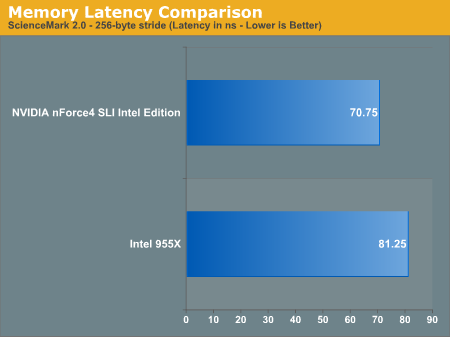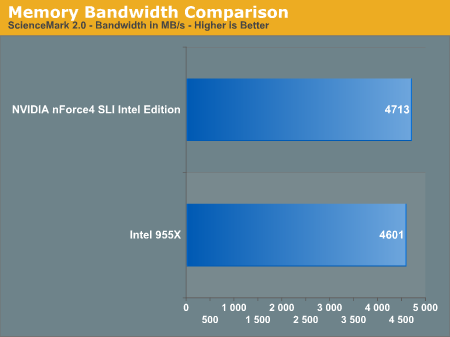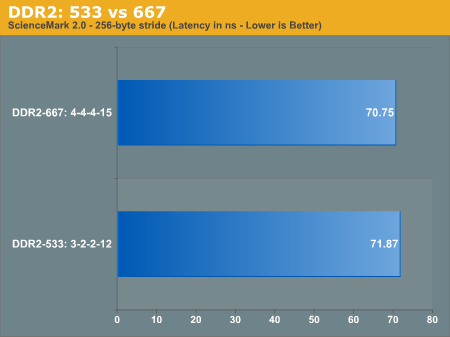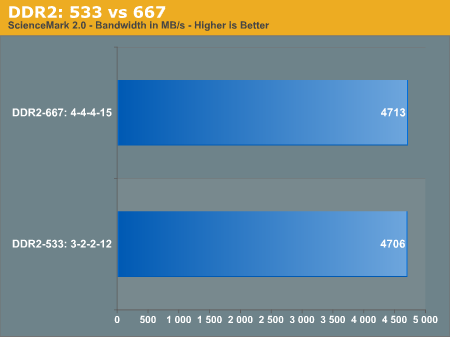Dual Core Intel Platform Shootout - NVIDIA nForce4 vs. Intel 955X
by Anand Lal Shimpi on April 14, 2005 1:01 PM EST- Posted in
- CPUs
Memory Performance
The biggest question on our minds when comparing these two heavyweights was: who has the better memory controller? We turned to the final version of ScienceMark 2.0 for the answer.

Amazingly enough, at the same memory timings, NVIDIA drops memory latency by around 13%. This is a worst case scenario for memory latency. In all of our other memory tests, the nForce4's memory controller was equal to Intel's controller - but even any advantage here is impressive, not to mention such a large advantage.

NVIDIA's latency reduction and DASP algorithms offer a negligible 2% increase in overall memory bandwidth. While you'd be hard pressed to find any noticeable examples of these performance improvements, the important thing here is that NVIDIA's memory controller appears to be just as good as, if not faster, than Intel's best. Kudos to NVIDIA - they have at least started off on the right foot with performance.
DDR2-667 or 533?
When Intel sent us their 955X platform, they configured it with DDR2-667 memory running at 5-5-5-15 timings. NVIDIA sent their nForce4 SLI Intel Edition board paired with some Corsair DIMMs running at 4-4-4-15 timings at DDR2-667. Given that we have lower latency DDR2-533 memory, we decided to find out if there was any real performance difference between DDR2-667 at relatively high timings and DDR2-533 at more aggressive timings. Once again, ScienceMark 2.0 is our tool of choice:

Here, we see that even at 3-2-2-12, DDR2-533 isn't actually any faster than DDR2-667.

...and it offers slightly less memory bandwidth.
It looks like there's not much point in worrying about low latency DDR2-533, as higher latency DDR2-667 seems to work just as well (if not a little better) on the newest Intel platforms.










96 Comments
View All Comments
mkruer - Thursday, April 14, 2005 - link
The only reason why Intel allowed Nvidia to make a chipset for them was for the SLI. Intel is worried, and rightfuly so that Nvidia's SLI sloution for AMD whould give AMD an advantage.Questar - Thursday, April 14, 2005 - link
"Honestly, Intel processors and even the platform haven’t been interesting since the introduction of Prescott. They have been too hot and poor performers, not to mention that the latest Intel platforms forced a transition to technologies that basically offered no performance benefits (DDR2, PCI Express)."Your opinion only, don't make this out to be fact.
"at the end of the day, Intel would still be happier if there was no threat from companies like NVIDIA"
nVidia (please print it correctly) is not a "threat" to Intel in the chipset market. They couldn't make a P4 chipset without a license from Intel. If Intel was threatened by them they wouldn't sell them a license. The purpose in licensing is give system builders more choice in design features.
"However Intel’s chipset team has reason to worry; motherboard manufacturers weren’t happy with the 925/915 chipsets, and with a viable alternative in NVIDIA, we may very well have an opportunity for NVIDIA to start eating into Intel’s own chipset market share in a way that no other company has in the past"
Intel probably makes as much net profit off the licensing of the nVidia chipset as they do selling thier own - after all thay don't have to design, build, ship or sell anything. So why would they be worried?
Really Anand, you have to begin thinking these things trough.
Houdani - Thursday, April 14, 2005 - link
Grrr, I should have noted that I was referring to the NCQ testing.Houdani - Thursday, April 14, 2005 - link
Anand: For the Intel DC Preview, what would you say was the queue depth during the various multitasking tests? I'm curious how today's test compares with how you tested the Intel DC in the preview.Also, is the relation between a depth of 8 versus a depth of 32 linear? Would there be any value in testing a depth somewhere in the middle, such as 16 and/or 24?
Thanks yet again for the quality work!
ChineseDemocracyGNR - Thursday, April 14, 2005 - link
"NVIDIA does not support Intel’s HD Audio spec, so you’re stuck with AC’97 on the nForce4 SLI. "That's inexcusable for a $80 chipset, IMO.
ksherman - Thursday, April 14, 2005 - link
cool and all, but is there any variation of the Intel-based SLI vs the AMD Based SLI?